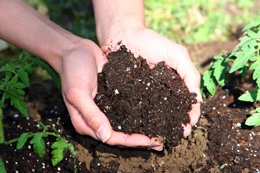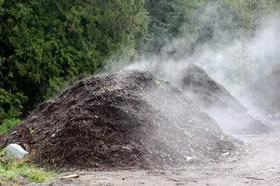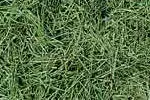
Aerobic Composting
Using Compost as a Renewable Energy Source
![]() Lots of gardening books state officially that “Composting is the process of producing aerobic compost through the decomposition of bio-degradable organic matter“. What that really means is that aerobic composting is a controlled and accelerated rotting down of organic matter by mixing organic waste with other ingredients to maximise its microbial growth.
Lots of gardening books state officially that “Composting is the process of producing aerobic compost through the decomposition of bio-degradable organic matter“. What that really means is that aerobic composting is a controlled and accelerated rotting down of organic matter by mixing organic waste with other ingredients to maximise its microbial growth.
Then we can say that Aerobic Composting uses the natural processes of rotting and decay to change once living organic wastes into valuable humus-like materials and minerals commonly called “compost” that Mother Nature uses to make the soil.
Instead of allowing Mother nature to take its own slow natural course of turning organic waste materials into compost, we can help her along her path of decomposition. As composting is nothing more than the speeding up of the natural decaying process by using micro-biological and chemical processes to return important plant nutrients such as nitrogen rich materials back into the soil where they can again be absorbed by other plants to generate new growth.

So why should we make compost. Compost is an excellent soil additive that increases the productivity and workability of the soil. By making the soil richer it helps plants grow which in turn helps the Earth in so many different ways from irrigation to sustainable food production. Which is why aerobic compost is prized by gardeners and garden centres alike often referring to it as brown gold.
Aerobic composting is also an inexpensive and green renewable resource that solves a lot of the problems associated with disposing of dead plants, kitchen wastes and other organic waste products which would otherwise by sent to a landfill. So besides producing a valuable renewable product for the garden as composting helps turn your waste into soil, “composting” is also recycling and is a good way in reducing the amount of landfill waste we produce.
But we must understand that aerobic composting is not producing a fertiliser, it is producing more of a soil enhancer. Mixing compost into the soil before planting or as an amendment to improve the soil, helping new plants to grow better and stronger. Mixing in compost also helps dry or sandy soils hold water and nutrients better.
Compost also loosens heavy or clay soils so water is absorbed and drains better, allowing roots to spread and weeds to be easier pulled up, as plants and the soil life can breathe. Two to four inches of compost mixed into the top eight to ten inches of garden soil throughout the planting areas will make a big difference not only to the plants themselves but to the life of the garden soil for years to come.
How to make Aerobic Compost
Basically to make aerobic compost, you simply gather organic material put it into a bin or a heap in the garden, aerate it and then add it to your soil. However, in reality aerobic composting is a little more involved than just that. The right quantity and types of materials you put into your compost heap makes a big difference to the quality and composting time of the resulting composted feedstock.
You need to think of your compost heap as a complete self contained ecosystem full of aerobic microbes, and to survive, this ecosystem needs the right mix of ingredients such as “Oxygen” (from the air), “Water”, “Warmth” and “Food” (from the composting materials), with the quality of the resulting compost depending on how well you control these four factors.
Decaying organic matter is a favourite haunt for many animals and insects with the red-worm (also known as Red Wriggler Worms) or the night crawler worms being the most important. Both red-worms, night-crawlers and even garden worms can eat vast quantities of decaying vegetation at one end and due to their digestive system, excrete from the other end organic compounds that enrich the composted feedstock, while their burrowing actions help separate and aerate the compost at the same time.
But as well as red-worms worms, naturally occurring active micro-organisms (mainly bacteria, aerobic microbes and fungi) do most of the hard work of breaking down the large organic materials into a fine compost material. All you have to do is provide them with the right conditions to grow and multiply and they will do all the work for you.
So the composting process is achieved by providing the right mixture of carbon and nitrogen (the feedstock), as well as water and oxygen from the air to encourage microbial growth. To be correctly composted, a material needs to have the following two important characteristics:
- The waste material must be organic and biodegradable.
- The waste material must contain things that are liked by micro-organisms to feed on.
So what types of waste can we put onto our “aerobic composting” heap. Firstly, lets start with what we should NOT put onto our compost heap. As well as the obvious glass, metal and plastics, we should not put: oil, fat, grease meat, fish or dairy products because of their tendency to attract flies and rats. Hard to kill weeds that produce seeds. Hard woody branches, stems or roots which take a very long time to decompose.
Diseased or insect ridden plants as these could infect or attack your healthy garden plants when the compost is used. Lime or acidic materials which could alter the ph value of the compost as the finished compost needs to be as near to ph neutral as possible. However, adding some wood ash will add potash to the pile which can be good. A golden rule for deciding what materials should not go into the compost heap is “if in doubt, leave it out”.
Having looked at some of the things we can not put into our compost heap, we can now look at what we can, and there are literally thousands to choose from. Animals and micro-organisms that turn plant material into compost need to have a balanced diet and just like us humans they need “energy” in the form of food to survive.
This energy is conveniently supplied by carbohydrates which contain Carbon, (C). But micro-organisms also need proteins in the form of Nitrogen, (N) and Phosphorus,, (P). Aerobic composting works at its best if these animals and micro-organisms are fed a mixture of carbon rich materials known commonly as “Browns” and nitrogen rich materials known commonly as “Greens”. But what are the “Greens” and “Browns” of aerobic composting.
Aerobic Composting Browns

Browns are also referred to as bulking materials as they give the compost heap volume and structure. These are hard dry materials such as dry fallen leaves, wood chips, twigs, cuttings, straw, paper, sawdust, pine needles, etc, or any other “brown materials” that are dry or woody in nature. But remember that dead bracken, sawdust, and straw contain virtually no nutrients, so use sparingly or as a mulch in the garden to improve the soil structure.
As well as providing the required carbon mix into the compost heap, bulkier brown materials help the compost pile to stay light and loose, allowing air to circulate more freely through the compost (hence the name of aerobic composting) speeding up the decomposition process.
Because woody brown waste breaks down much more slowly than soft green waste, shredding these materials first increases the area that aerobic microbes and other micro-organisms have to work on as well as reducing the volume of the pile. Soil invertebrates such as mites, ants, centipedes, beetle larvae, etc, are all responsible for the physical breaking down of tough brown materials as well as fungi-like bacteria.
Aerobic Composting Greens

Greens are referred to as food materials as they are colourful and wet providing nutrients and moisture for the compost workforce. Green wet materials are excellent additives for aerobic composting and include waste food scraps, grass cuttings, animal manure, fleshy plants and leaves, even tea and coffee waste are all considered to be green waste.
If too much green material is added to the compost pile, it will become too wet and compacted and will begin to smell as the result of anaerobic (bacteria that does not require oxygen) bacterial action. Food waste generally has a high moisture content and are usually wet enough to keep the pile moist. A good aerobic composting pile should be moist, but not soaking wet.
The Composts Carbon-to-Nitrogen Ratio
In aerobic composting, the carbon to nitrogen ratio of the decaying matter in the compost heap is very important in producing a quick result. For example, a pile of leaves or sawdust (brown matter) will sit for years without much decay while a pile of grass cuttings or fleshy plant stems (green matter) will turn into a soggy and smelly mess. So the right mixture of greens and browns, known commonly in the gardening world as the Carbon-to-Nitrogen ratio or C/N ratio, is important.
So what is the ideal C/N ratio for an aerobic compost heap?. Most gardeners and gardening experts believe that the a good ratio of carbon to nitrogen in a compost heap is about 25 to 30 parts carbon rich material to 1 part nitrogen rich material, in other words 30:1. An aerobic composting heap with a ratio much higher than 30 would take a long time to decompose, while a ratio much less than 30 would end up with a smelly algae type mess. Then we can summarise the difference between browns and greens as follows.
Browns and Greens in Composting
| Brown Materials | Green Materials |
|---|---|
| Carbon rich organic waste | Nitrogen rich organic waste |
| Decompose very slowly | Decompose very quickly |
| Coarse browns can help aerate compost | Poor aeration of the compost |
| Woody residue if not fully composted | Produce ammonia gas if composted alone |
| Browns are more abundant in the Autumn and Winter | Greens are more abundant in the Spring and Summer |
| Browns tend to be drier than greens | Greens tend to be more wet than browns |
This carbon-to-nitrogen (C/N) ratio does not need to be exact as ratios of 25:1 to 40:1 will still produce an efficient compost pile and regular turning of the compost heap helps aerate the pile as well as mix the browns and greens together.
As well as green and brown materials, aeration, or air movement through the pile, (hence the name Aerobic Composting) is necessary for efficient decomposition and for the survival of air-breathing micro-organisms and larger soil life forms.
Aeration occurs naturally as air warmed by the decaying process rises up through the pile drawing fresh air from its surroundings. Turning your compost heap once or twice a week, or adding coarse, dry material to the compost heap can improve aeration, inhibit odour-causing bacteria and help speed up the composting process.
The action of turning over the compost regularly to accelerate its decomposition process is called active composting while piling up the compostable materials and letting them decompose naturally at natures own slow rate is called passive composting. This method can often take a year or more to create any usable compost.
When the composted materials look like rich, brown soil, it is ready to use. Compost can be applied either as a top dressing or dug into the garden soil throughout the summer. Compost is also excellent for reseeding lawns, and it can be spread one-quarter inch deep over the entire lawn to rejuvenate the turf. To make potting soil, mix equal parts of compost, sand and loam and sieve together removing any large particles which can go back into the compost heap.
Aerobic Composting Summary
We have seen that composting is the controlled decomposition of organic materials and the speed of composting is dependent upon the moisture, aeration, and carbon-to-nitrogen ratio of the compost heap.
Layering and choosing the right organic materials creates the right environment for composting to occur. A hot, steamy pile of compost is generally a definite indication that the ideal conditions required to produce good black compost have been met.
Aeration of the pile and moisture content are generally the main two factors affecting the time of decomposition necessary to produce a good finished compost feedstock. Generally weekly turnings of the composting pile will help produce aerobic compost in only few short months, while monthly turnings may produce usable compost over a full season.
Aerobic Composting can be achieved using brick, wooded or concrete structures placed in the garden or simply by using commercially available composting bins which may also be used indoors but all composting containers must resist decay, and allow air flow. Multiple composting containers next to each other allow for the compost pile to be turned more easily speeding up the process.
While aerobic composting does not produce any usable energy as such, it can still be considered as a Renewable Energy Resource as the benefits of composting materials include: improved soil and root structure producing healthier plants and crops, reduction in the use of chemical fertilisers, release of non-contaminating nutrients back into the environment, improved water infiltration and drought tolerance of soils as well as other uses in biomass systems and bio-filters.
Then Aerobic Composting is not an art or science that’s complicated to understand. In fact the decomposition of organic matter has been going on ever since there has been carbon rich organic matter on the Earth or at the very least, its as old as the soil. If done correctly, composting is simple, odourless, and produces a valuable, natural soil resource which is a good alternative to landfill or incineration. Just create a pile, sit back and let it rot!.
In the next tutorial about Composting, we will look at a process which produces compost without the need for oxygen or aeration of the pile. This type of compost generation is called Anaerobic Composting.
To learn more about how “Aerobic Composting” works, to obtain more information about the various composting methods and materials available, or to explore the advantages and disadvantages of composting, then Click Here today to get your copy of one of the top “Composting Guides” today from Amazon and learn more about the different ways to produce good quality compost in your garden to save money and the environment.











Pls cantact
Very informative. I have been gardening for many years, making compost as I do. Suddenly aerobic compost is sold as well as zoom lessons to make your own. At least I am satisfied that I have done it all fairly successfully.